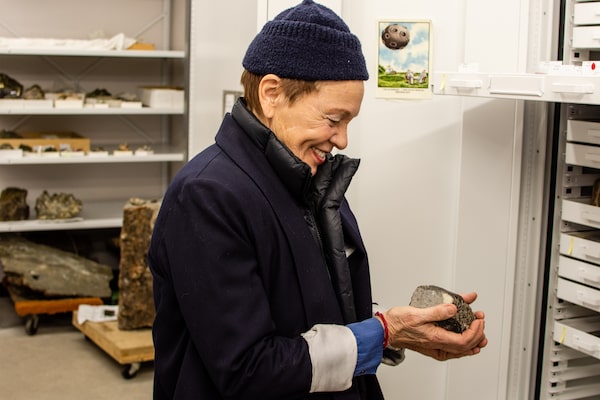
Artist Laurie Anderson holds a 4.5-billion-year-old meteorite at the Royal Ontario Museum. Chelsea Brash/Royal Ontario MuseumChelsea Brash/Handout
The multidisciplinary artist Laurie Anderson visited the Royal Ontario Museum in Toronto this week and held a 4.5-billion-year-old meteorite in her hands. It fell to Earth in a North African desert and was introduced to scientists in 2003, a rare visitor from deep time and outer space.
“I started to cry,” Anderson said later that day as she packed up her gear after delivering the annual Eva Holtby Lecture at the museum. Anderson, a violinist and experimental musician (who is performing a sold-out concert at Koerner Hall on Saturday), a filmmaker, visual artist and author, has been thinking a lot about space rocks and ticking time these days.
Her lecture was partly about virtual reality. To the Moon, her 15-minute VR collaboration with the Tawainese artist Hsin-Chien Huang, takes participants to the lunar surface, where they fly over dinosaur and whale skeletons made up of strands of DNA, get pummelled by space debris while travelling by donkey and soar up a mountain only to get dropped off the other side. Let’s just say it’s a loose and mythical moon; when the piece, which is visiting the ROM this month, was shown at the American Museum of Natural History in New York, staff wanted a disclaimer warning visitors there are no donkeys on the moon. At least, that’s how Anderson tells the story.
VR is, for her, just another way of telling stories. When her collaborator first suggested she try the new technology, she declined because she thought it made flesh look rubbery and humans creepy. On the other hand, she couldn’t resist a medium that lets you fly. So, To the Moon takes place in a universe of black and white illustrations and, apart from one’s own avatar, a blocky figure in a spacesuit, no humans appear. The work is dedicated to an ancient Chinese artist who spent years making a hugely detailed vertical painting of a mountain: When he was finished, he walked into his landscape.
Perhaps its most poignant passage is one where Anderson’s distinctive lilt offers a rare bit of narration: “The reason I really love the stars is because we can’t hurt them; we can’t burn them or melt them … We can’t flood them or blow them up.”
We can, however, flood, burn or melt just about everything else. For all her renowned experimentation with media, Anderson is a techno-skeptic. Her talk featured a large slide of the quote, “If you think technology is going to solve your problems, you don’t understand technology and you don’t understand your problems,” turning a more mundane thought from the computer security expert Bruce Schneier into a Buddhist koan. So, don’t depend on some new gizmo to start sucking carbon dioxide out of the air.
Anderson got her own taste of the climate crisis when Hurricane Sandy hit New York in 2012 and flooded the basement of her studio, destroying her entire archive. As she has told the story, she recovered immediately, relieved that now she never had to clean the basement.
“That’s not entirely true,” she admitted this week, as she unplugged a keyboard and slipped her violin into its case. “I’ll go and look for something, and it’s gone forever. I’m not as collected as I said.”
Her 2018 collection of essays, All the Things I Lost in the Flood, suggests language can replace things and stories can fix problems. At least, she hopes so.
“Stories are things you tell to other people, and we are the first human beings facing the possibility of our own demise, the first ones who are being asked to tell a story to no one. Is there ever a story you tell to no one?”
She will keep trying. It’s either that or plant three trillion trees.
Live your best. We have a daily Life & Arts newsletter, providing you with our latest stories on health, travel, food and culture. Sign up today.
 Kate Taylor
Kate Taylor